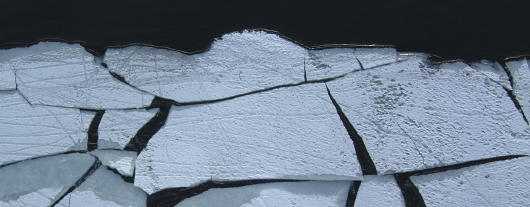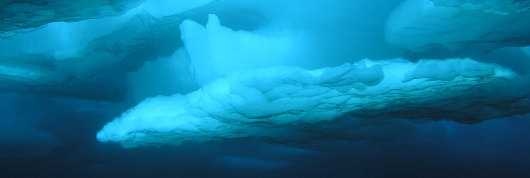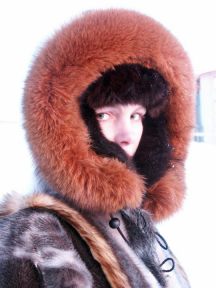|
http://www.ipy.org/index.php?/ipy/detail/sea_ice/
International Polar Day - Sea Ice
September 21st, 2007 marks the first of quarterly
International Polar Days.... this time focusing on Sea Ice.

Pancake ice image - US National Science Foundation
About Sea Ice
Sea ice, the thin layer of ice that covers most of the Arctic Ocean and
surrounds most of the Antarctic continent, represents a distinctive feature of
our planet. Sea ice spreads and retreats seasonally. It drifts and packs under
the influence of wind and currents. It isolates the atmosphere from the ocean
and produces the coldest saltiest ocean waters. It restricts the movement of
ships but supports the traverses of bears. Sea ice contains unique organisms
that sustain under-ice ecosystems. Poised where slight warming converts ice to
water, sea ice has an exquisite sensitivity to climate. Its disappearance from
any region, at any season, will represent a profound planetary change.
Understanding sea ice and predicting its future represents a crucial challenge
for IPY.
Download this flyer about
IPY and Sea Ice or read it on this
IPY and Sea Ice webpage.

broken ice against dark water - Swedish Polar Secretariat
Sea Ice For Press
(press releases, contacts, images, projects)
Sea Ice for Educators
(experiments, resources, live cruises, polar activities and more)
Launch a Virtual Balloon
(show your involvement in this International Polar day)
IPY Projects Studying Sea Ice
Over 30 IPY projects study some aspect of Sea Ice. This includes ship
expeditions, remote sensing, sea ice ecosystems, the importance of sea ice to
polar bears and marine mammals, climate research, exhibitions, and books.
Contact IPY Sea Ice Scientists
(click for contacts).
Research Projects and Expeditions
Sea Ice is currently being studied both from expeditions and by remote sensing.
These include the following: (more details on the
expedition page)

iceberg - US National Science Foundation
Antarctic Sea Ice in IPY (ASPECT) (IPY
Project 141)
ASPECT has a number of associated expeditions investigating
Sea Ice. These include:
SIPEX: Sea Ice Physics and Eco-system eXperiment
This Australian led expedition to the Southern Ocean will be conducting a range
of exciting experiments in the sea ice that surrounds the Antarctic continent
during September and October 2007. The cruise involves 45 scientists from 8
different countries, as well as two teachers developing educational activities
and real-time opportunities for classrooms and media around the world.
CliC Marine Cryosphere program
Sea ice thickness is fundamental to the understanding of climate, ocean
circulation and polar biological systems. However, routine, comprehensive sea
ice thickness measurements are not available. Leading sea ice scientists from
the Climate and Cryosphere (CliC) project discussed how to determine
circum-Antarctic sea ice thickness on time scales ranging from days to seasons
to years. Read this
summary, including directions for future research. For hard copies, please contact
clic@npolar.no
DAMOCLES Expeditions (IPY Project ID
40)
DAMOCLES (Developing Arctic Modeling and Observing Capabilities for Long-term
Environmental Studies) is an integrated ice-atmosphere-ocean monitoring and
forecasting system designed for observing, understanding and quantifying climate
changes in the Arctic. DAMOCLES is specifically concerned with the potential for
a significantly reduced sea ice cover, and the impacts this might have on the
environment and on human activities, both regionally and globally. The DAMOCLES
project is collecting data from a variety of locations, including floating
platforms, ships, aeroplanes, and satellites. DAMOCLES expeditions occurring now
include the RV Polarstern and polar schooner, Tara.
ICED-IPY (IPY Project 92)
Changes in sea ice can have a direct impact on ecosystems in many ways, for
example, through shifts in the amount of habitat available for ice- associated
animals.
Understanding more about how climate processes affect the marine ecosystem of
the Southern Ocean is of great importance and forms a key focus of the ICED
programme. ICED is forging new links between scientists working in different
areas to improve understanding of the links between climate and biology.
Read more about
ICED projects related to Sea Ice
IPY-Circumpolar Flaw Lead (CFL) System
Study
A major international effort under Canadian leadership that aims at
understanding how changes in the physical system affect biological processes,
towards a better understanding of the potential effects of climate change. The
CFL Project is part of IPY 26
Sea Ice & Arctic Marine Ecosystems. Download more information in these fact
sheets:
ANDRILL (IPY Project 256)
A multinational science group drilling geologic sediment cores from the ocean
floor under the sea ice in the Ross Sea. Although the project is not studying
sea ice specifically, an understanding of its dynamics is essential. The drill
has been specially designed to drill through the sea ice and then through the
water column to the sea floor.
NORCLIM (IPY Project 120)
The NORCLIM programme is about human adaptation to rapid climatic change during
the last 2000 years. Three key areas have been selected, based on archaeological
evidence and potential to obtain high quality marine sediment cores. These cores
are excellent archives of climatic and environmental change. After an expedition
to Svalbard earlier this month, the next expedition will focus on the fjords of
Newfoundland where archaeological evidence on land is well studied. The research
will be carried out onboard the Russian R/V Akademik loffe.
Arctic GOOS (IPY Project 379)
The overall objective of IPY Arctic GOOS to develop and implement operational
monitoring and forecasting systems in the Arctic Ocean and adjacent seas. The
systems will be based on state-of-the-art remote sensing, in situ observations,
numerical modelling, data assimilation and dissemination techniques. Several
components of Arctic GOOS are presently in operation, producing daily
information that can be downloaded from web sites. These pages also shows latest
information on Sea Ice.
National Snow and Ice Data Centre
The National Snow and Ice Data Centre (NSIDC) will be issuing
Sea Ice updates 1-2 times per week through the first week of October,
marking the end of the 2007 melt season with a formal press release summarizing
the data and findings. The NSIDC site includes an
All About Sea Ice education site as well as
Sea Ice Information for Press with high-resolution graphics, an RSS feed for
automatic notification of updates, and
Frequently Asked Questions About Sea Ice.
Ice Logistics Portal
The IPY
Ice Logistics Portal is a joint initiative of JCOMM-ETSI and Polar View,
aimed at creating a convenient point of access to operational sea ice
information produced by the world’s ice services. Access to products is provided
via a series of pre-defined regions for both the Arctic and the Antarctic. Since
the primary focus of the IPY Ice Logistics Portal is on operational sea ice data
(i.e. ice charts), only the most recent information is displayed for any given
region.
Sea Ice Video Conference and Webcast
1600 UTC, 1800 Germany, Noon Eastern, 10 AM Mountain Time, 8 AM Alaska

US NOAA (National Oceanic and Atmospheric Administration)
Images
Polar Image Libraries
Sea Ice and Icebergs (International Polar Foundation)
Sea Ice Images (Australian Antarctic Division)
Ice in the Sea Images (UNEP: Global Outlook for Ice and Snow)
Cool Antarctica Sea Ice Images
ArcticNet Photo Gallery
Circumpolar Flaw Lead Book Gallery
Additional Sea Ice Related Links and Resources
Global Outlook for Ice and Snow (United Nations Environment Programme)
graphics, images, background information and an entire chapter on Ice in the Sea
Why We Care: Sea Ice Basics (Lamont-Doherty Earth Observatory)
Sea Ice - An Antarctic Habitat (Alfred Wegener Institut)
Organisms that Thrive in Arctic Sea Ice (National Ocean and Atmosphere
Administration)
Current Arctic Sea Ice Extent (Canadian Cryospheric Information Network)
Sea Ice Primer (US Army Cold Regions Research and Engineering Laboratory)
Icebergs and Sea Ice Suitcase Lessons (Oregon State University)
Presentations from a Sea Ice Conference(NOAA)
NSIDC Education Centre
The Shrinking Arctic Ice Cap (NOAA) animations, images, latest model results
About International Polar Days
In response to journalists and educators wanting an ‘angle’ on the extremely
broad International Polar Year, quarterly “IPY Days” are being planned that
focus on a particular aspect of polar research. These days will include press
releases, background information, access to experts, links to images and video,
educational and community activities, and connection to researchers in the
field. The first of these will be held on September 21st and will focus on Sea
Ice. Future Polar Days will focus on topics including Ice Sheets, Marine
Biodiversity, and Human Health.
International Polar Days were originally planned to occur
around the solstices and equinoxes to mark the changing solar cycle, experienced
in the extreme at the polar regions. In the summer, the polar regions experience
24 hours of sunlight, in winter, the sun is continually below the horizon, and
at the equinoxes the sun is above the horizon for 12 hours all over the world.
More information can be found here:
Solstices, Equinoxes, and the Polar regions
Image credit: Pancake ice image - US National Science
Foundation; broken ice against dark water - Swedish Polar Secretariat; iceberg -
US National Science Foundation; underwater ice - US NOAA (National Oceanic and
Atmospheric Administration)
Click Here to go to
the North Pole Expedition 2005 Exhibit.
Click
Here to go to the North Pole Expedition 2002 Exhibit.
Click
Here to go to the North Pole Expedition 2001 Exhibit
Click
Here to go to the Main Adventure Exhibit Index.
Click Here
to go to the Yellow Airplane Museums Main Index.
Click
Here to see other incredible adventures you can take.
Click Here
to go to a list of Airplane Museums in the United States.
Click Here's
a link to the NASA Site
|

